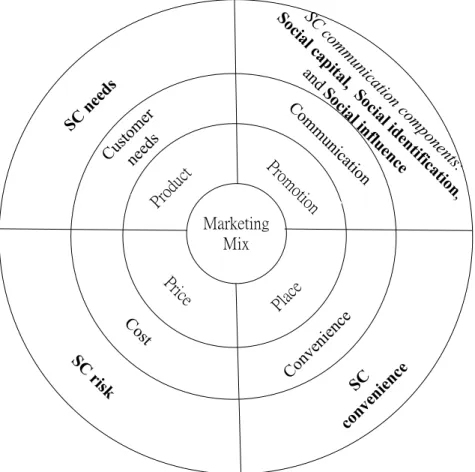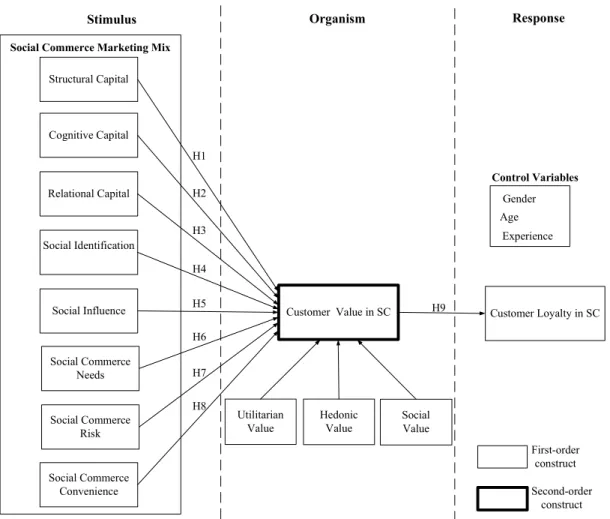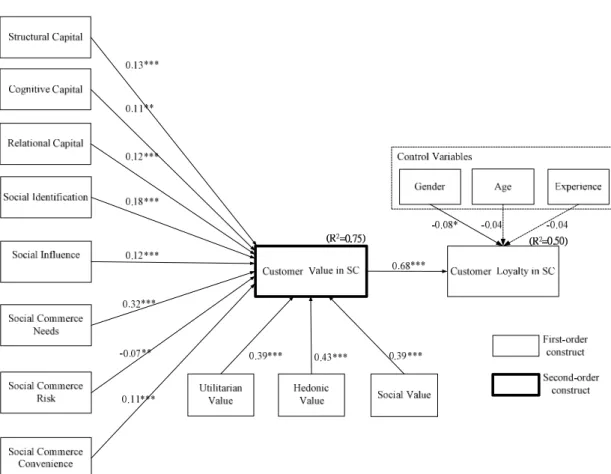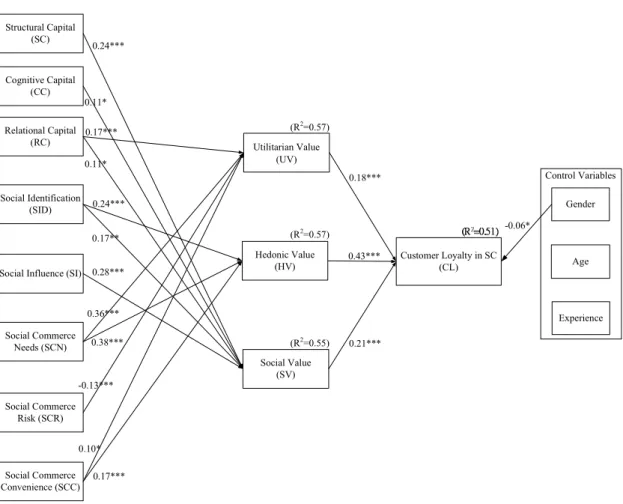The S-O-R theory has been considered a psychology theory popular in the studies of consumer behavior (Fiore and Kim, 2007; Chang et al., 2011). In contrast, the push mode refers to the communication that a network member receives from others in the social network. Next, the customer needs component is usually driven by utilitarian and hedonic motivations; but in the SC context it also involves social motivation (Rintamäki et al., 2006).
Therefore, we propose to expand the comfort component in the 4Cs with SC comfort in this study.
Hypothesis development
Based on the discourse above, relational capital can increase customer value in SC; therefore, we propose the following hypothesis. In summary, customer value in SC (i.e., utilitarian, hedonic, and social values) could promote CL; therefore, we propose hypothesis 9.
Research methodology 1. Research model
Since the survey was administered in Chinese, we performed translation and back-translation to ensure the semantic consistency of each item between English and Chinese (Brislin, 1970). A panel of three experienced IS researchers and three senior IS managers with knowledge of social commerce assessed each back-translated item to ensure that the semantics of the original item were well preserved. Furthermore, a small-scale pre-test of the questionnaire was conducted with 6 experts in the field of electronic commerce using their SC experience to ensure the questionnaire's correctness, ease of understanding and contextual relevance.
Next, a pilot test was conducted with 300 Facebook users to confirm the measurement properties of the final items. These individuals were asked to fill in the questionnaires and give their opinion on the content of the questionnaire. The results showed that Cronbach's α exceeded 0.7 for all constructs and factor loadings of all items were above 0.5, supporting the reliability and validity of the final questionnaire (see Appendix).
For the SC context of this study, we target the members of Facebook because it is the largest social networking site in the world (Compete, 2016). To ensure that the participants were buyers of C2C commerce on the SC platforms, they must have experience of SC shopping from individual sellers on Facebook. The eligible participants were instructed to answer all the questions in the questionnaire based on their social shopping experience.
Data analysis
A caveat offered by Chin et al. 2003) is that the repeated indicators approach would cause the R-squared for the second-order construct to end up as 1.0. The adequacy of the measurement model was assessed based on the criteria of reliability, convergent validity and discriminant validity. Furthermore, the convergent validity of the scales was verified using two criteria suggested by Fornell and Larcker: all interfactor loadings should exceed 0.7 and (2) the average variance extracted (AVE) from each construct should exceed the variance due to error. of measurement for that construct (ie AVE should exceed 0.5).
Second, the square root of the AVE from a construct is greater than all correlations between the construct and other constructs in the model (Fornell and Larcker, 1981) (see Table 5). Furthermore, to access common method bias, a post hoc Harman's single factor test was performed by running an exploratory factor with all variables included (Podsakoff et al., 2003). In summary, the value-loyalty base model accounted for 50% of the explained variance of CL on Facebook (R2=50%), and the explained variance for customer value in SC (R2=75%) accounted for by the SCMM components was also acceptable.
To further test the potential effect of customer value on CL on Facebook, we unfolded the overall model to examine the impact of each SCMM component on individual dimensions of customer value in SC, which in turn influence the CL. The result shows that the value-loyalty model accounts for 51% of the explained variance of CL on Facebook (R2=51%). The levels of explained variance for utilitarian value (R2=57%), hedonic value (R2=57%) and social value (R2=55%) accounted for by SCMM components are also acceptable.
Conclusions and discussion
Thus, social sellers should promote structural capital, cognitive capital, and relational capital through social media to increase customer value in SC. This is consistent with the concept of "citizenship" as articulated in the organizational behavior and marketing literature, to build community identification and influence to enhance collective value creation between and among customers and sellers (Algesheimer et al. confirmed that a customer chooses a product/service driven by other influential individuals and Bhattacharya and Sen (2002) also agreed that the identification bond can be used in implementation strategies to increase customer value.Consequently, the social sellers should leverage social identification and influence to increase higher levels of customer value in SC.
Therefore, social sellers should provide clear product description and prevent social network members from buying and receiving unexpected products, leading to improved customer value in SC. Therefore, social sellers should provide appropriate channels through social media to promote customer value in SC, e.g., by saving time and effort to find products, tracking order processing progress more effectively, and made more like-minded friends to discuss common topics of interest, etc. SC makes the social networking platform of the same type appear rapidly due to the popularity and low technology threshold of websites.
Furthermore, although the three value dimensions are important indicators of customer value in SC, their importance is not the same as shown in Figure 4. According to Rintamäki et al. 2006), we treat all three value dimensions as purchasing dimensions; utilitarian value can be considered as a foundation, but usually cannot distinguish a company and its products; complementing utilitarian value with hedonic and social dimensions of customer value is a real advantage. Because of the trust between sellers and customers in the social media community, social media sellers with high relational capital are more likely to increase the utility value of the product/service. Therefore, with greater shopping convenience and lower risks in SC, customers may perceive greater utility value of goods during the purchasing process.
Implications and future research 1. Theoretical contributions
An Overview and Recommended Two-Step Approach,” Psychological Bulletin, Vol. 2010), “Getting value from social commerce networks”, Journal of Marketing Research, Vol. 2000), “Atmospheric effect as a tool for creating value and gaining customer share,” Journal of Business Research, Vol. 1994), “Work and/or Pleasure: Measuring Hedonic and Utilitarian Retail Value,” Journal of Consumer Research, Vol. 1997), self-efficacy: exercising control, Freeman, New York. A framework for understanding consumers' relationships with businesses,” Journal of Marketing, Vol. 2001), “Understanding Information System Continuity: An Expectation Confirmation Model,” MIS Quarterly, Vol. 2007), “Developing a Sense of Virtual Community Measure,” CyberPsychology and Behavior, Vol. 1998), “A dynamic model of the duration of the customer's relationship with a continuous service provider: the role of satisfaction”, Marketing Science, Vol. Understanding Knowledge Sharing in Virtual Communities: An Integration of Social Capital and Social Cognitive Theories”, Decision Support Systems, Vol. 2015), “Resolution Strategy for Unintentional Criticism in the Online Space”, Internet Research, Vol. 1988), “Social capital in the creation of human capital”, American Journal of Sociology, Vol.
Social Capital and Student Use of Online Social Networking Sites”, Journal of Computer Mediated Communication, Vol. 2011), “Connection Strategies: Social Capital Implications of Facebook Communication Practices,” New Media & Society, Vol. 2003), “Empirically Testing a Model of Online Store Atmosphere and Customer Responses,” Psychology and Marketing, Vol. An Investigation of the Influencing Role of Habit", Internet Research, Vol. 2007), "An Integrative Framework Capturing Experiential and Utilitarian Shopping Experience", International Journal of Retail and Distribution Management, Vol. 1975), Belief, Attitude, Intention, and Behavior : An Introduction to Theory and Research, Addison-Wesley, Reading, MA. 1981), 'Evaluating structural equation models with unobservable and measurement errors', Journal of Marketing Research, Vol. 2003), 'Consumer patronage and risk perceptions in Internet shopping ”, Journal of Business Research, Vol. The influence of perceived value on purchase intent in the context of social commerce", Internet Research, Vol. A study of the effect of a service provider's personality,” Journal of the Academy of Marketing Science, Vol. repeat buying behavior”, Journal of Marketing Research, Vol.
Based on the stimulus-organism-response model”, Journal of Research in Interactive Marketing, Vol. 2001), “Effects of relationship marketing on repeat purchase and word of mouth”, Journal of Hospitality and Tourism Research, Vol. 1998), Principles and Practice of Structural Equation Modeling, Guilford Press, New York. A social capital perspective”, Research Policy, Vol. 2011), “What drives social commerce: The role of social support and relationship quality”, International Journal of Electronic Commerce, Vol. 2014), “Exploring the relationship between intentional and behavioral loyalty in the context of e-tailing”, Internet Research, Vol. 1988), "Correlates of Price Acceptability", Journal of Consumer Research, Vol. 2015), “Predicting mobile social network adoption based on mobile value and social influence”, Internet Research, Vol. 1986), "Social identification effects in group polarization", Journal of. A definition and theory”, Journal of Community Psychology, Vol. 1974), An Approach to Environmental Psychology, MIT Press, Cambridge, Mass.
Site Jumps into Ecommerce,” Advertising Age, Vol. 2001), “Conceptual and Operational Aspects of Brand Loyalty: An Empirical Study,” Journal of Business Research, Vol. Modeling consumer buying behavior in social shopping communities with clickstream data”, International Journal of Electronic Commerce, Vol. 1975), Markets and Hierarchies: Analysis and Antitrust Implications, Free Press, New York. An Empirical Study and Implications of Marketing”, Journal of Marketing, Vol. 2006), “Dividing the value of department store shopping into utilitarian, hedonic and social dimensions: Evidence from Finland”, International Journal of Retail and Distribution Management, Vol. 1994), Quality of Service: Insights and Management Implications from the Frontier, Sage Publications, New York. Van der Heijden, H., Verhagen, T., and Creemers, M. 2003), “Understanding online purchase intentions: contributions from technology and trust perspectives”, European Journal of Information Systems, Vol. 2004), “Evolving towards a new marketing dominant logic”, Journal of Marketing, Vol. information technology: Towards a unified view,” MIS Quarterly, Vol. 2002), “Product Attributes and Internet Shopping Intents,” Internet Research, Vol. 1995), “Relational aspects of computer-mediated communication:.
A mean model and synthesis of evidence”, Journal of Marketing, Vol. 2016), “Building brand loyalty in social commerce: The case of brand microblogs”, Electronic Commerce Research and Applications, Vol. 2010), “Explaining mobile community user participation from a social capital perspective", International Journal of Mobile Communications, Vol.




